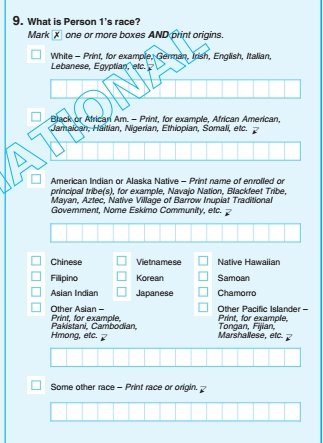A National Public Radio story reports that the 2020 U. S. Census will ask more detailed questions about race and ethnicity, as shown to the left on one of the possible new forms. (Click image to enlarge.)
I can appreciate not being labelled simply as "white" as if some races have further identities but white is simply white. However, it sure complicates filling out the form, and I have my doubts about how much useful information it will generate. I know more about my ancestry than most Americans, and I can't answer this question.
There simply is no room in those boxes to enter "English-German-Welsh-Irish-Scottish-French-Dutch." And if I manage to confirm the (currently quite speculative) Swiss branch, is that really Swiss, given that the family came to Switzerland from Germany? Is my French really French, given that it is actually Norman French, and the Normans were largely invading Vikings from Scandinavia? There's a good chance much of my English is also orignally Scandinavian—DNA testing suggests this as well—and my Scottish may have been originally Irish and vice versa.
Given that my most recent immigrant ancestors came to this country in the 1700's, I think I'll fill in the blank with "American" and let the chips fall where they may. But I've only learned this information recently, after years of research. That kind of research is even more difficult for African-Americans, thanks to slavery and the "1870's wall," but at least the census offers "African American" as a choice—which just happens to fit exactly into the boxes allowed. I suppose I could try "European American"—but that won't fit.
How many Americans know their ancestry further back than their grandparents, anyway?
There's going to be a lot of guesswork going on.
I am not "white".
My father was Puerto Rican. The first Villafañes to come to Puerto Rico arrived in 1512. They were servants to the first Roman Catholic bishop the King and Queen of Spain sent to Puerto Rico. These two Villafañe men came from the town of Villafañe in what was then the Kingdom of León, in the northwest corner of Spain, now called Galicia.
Now, there have been many groups of people who came to Spain: Prehistoric Megalithic Cultures, Bronze Age people, Celts, Roman soldiers (a motley crew from all over the Empire...) Suebic invaders, Visigoths, Britons...
The Spaniards who came to Puerto Rico with and after Columbus mixed with the local native Taínos, and later with the African slaves. So most Puerto Ricans are not lily white.
My maternal grandfather was born in Italy, but he was of Dutch descent. My maternal grandmother was descended from Italian peasants(in themselves a mixture of all kinds of people).
So how do you plan to fill in the form? I've modified the post to show all choices. "Other" is tempting, but still doesn't give enough room.
Other:Mixed Hispanic (not a race, but part of a group of peoples that have some degree of Spanish colonial ancestry, and speak Spanish)
I suspect the vast majority of people aren't going to think about genealogy at all. They are going to fill in whatever they think they probably are. ("Oh, I think I've got mostly German" or, "my grandmother was Italian" etc.)
Diane - it was neat to see a glimpse into your origins - and now I know how to pronounce your name! (since the ñ doesn't print usually)
well, I tried to do the html for the enya but obviously it didn't work.
ñ it needs a semicolon at the end of your ñ.



